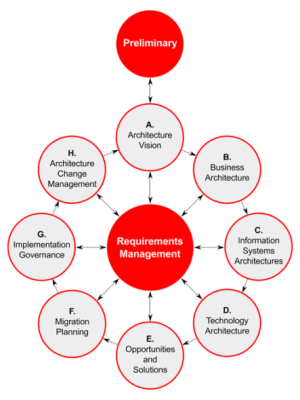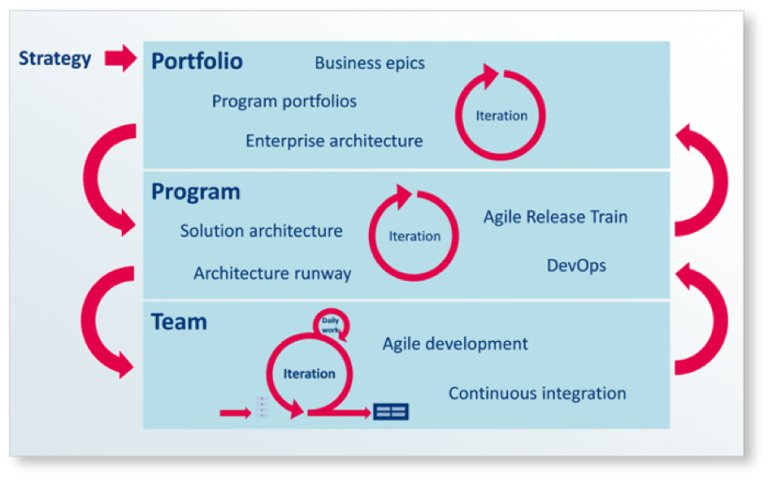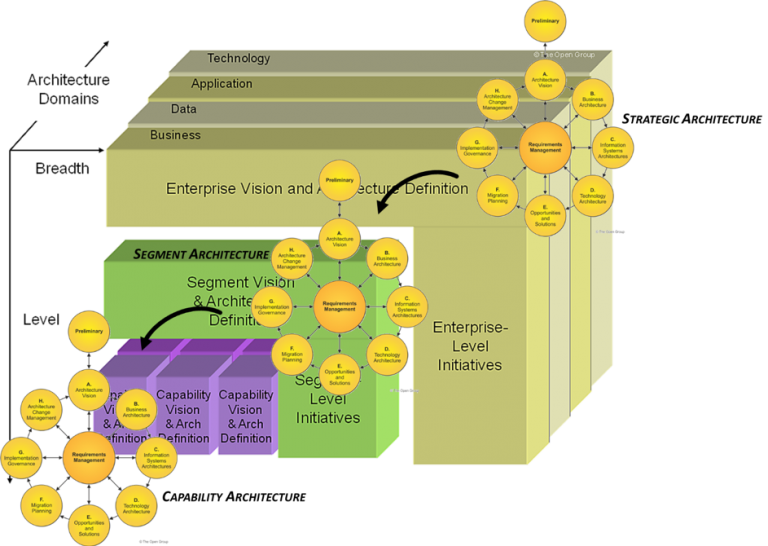Agile and the TOGAF ADM
The core of the TOGAF is the Architecture Development Method, ADM. Looks like a waterfall approach, but it’s not necessarily. The individual phases and groups of phases can be completed in an agile manner and in sprints.


One of the primary goals of Phase A is a consensus on the “vision”. One could argue that a phase A defines an “epic”. Alternatively, another phase A could define a “User Story”. Phase A can define the “Program Increment” for an “Agile Release Train”. Each of these things can be mapped at different levels on Phase A: Architecture Vision. Transferred to SAFe Agile, Phase A could also map and simplify the definition of “strategic topics at the corporate level” or “value streams at the program portfolio management level”. TOGAF’s “Capability-Based-Planning” aids here.

From an enterprise architecture and IT perspective, capability-based planning is a powerful way to ensure that the strategic business plan leads the enterprise from top to bottom. It can also be adapted using capability engineering to take advantage of emerging bottom-up innovations. Regardless of how the organization itself is structured, it must manage the delivery of business capabilities whose implementation requires coordination and alignment across all business units. The functions are ideally business oriented. One of the main challenges is that the benefits are often achieved at company level and not at divisional or departmental level. As a result, projects in sector- or department-oriented portfolios tend to work more from their own perspective than from the company’s perspective. Managing the delivery of a capability is a challenge but anchoring a capability-based perspective in a company is a powerful mechanism to achieve synergistically derived business value that translates into profitability and stock value.
Every agile iteration at every level – and every ADM iteration at every level – must involve stakeholders and their requirements. Some stakeholders can be considered “Epic Owners” or “Persona” in a “User Story”.
Stakeholder management is of crucial importance in TOGAF. Anyone who fails in stakeholder management risks not achieving the goals that have been set. 80% of transformation projects fail precisely because of this – and at Agile everything revolves around stakeholder management. In an agile context, Epic owners are directly involved throughout the agile design process. Agile says that and TOGAF says exactly the same thing.
Requirements and design arise when we iterate in agile sprints and ADM cycles. Always directly and continuously connected with our stakeholders – shoulder to shoulder, in the same room, in the same Scrum teams.
It must be decided to what extent phases B, C and D are relevant and what needs to be done in relation to these architectural domains or “concerns” (Concerns). Ideally, the result of phase D is already defined, and it can be assumed that the technical architecture is rather durable, already given and reusable. So, the teams in your sprints focus only on phase B and C – the business architecture, application architecture and data architecture. Of course, it doesn’t have to be that way. You might as well do agile design and iteration for the provision of an infrastructure technology or platform, but I don’t think Agile was really designed for that purpose.
It’s likely that phase D: technology architecture is a kind of “architecture epic” that we will realize separately. I don’t think Phase D is very often designed or realized in a sprint or program step. Rather, I am convinced that an agile sprint will focus on business architecture, application architecture and information/data architecture. Phases B and C.
It is necessary to determine what is available and given (baseline) and where they want to go (target). In fact, development is rarely carried out on greenfield sites. Therefore, it may be good to know what we’re assuming. There may be restrictions or requirements that need to be known, there may be principles that have already been adopted that need to be adhered to, Phases B and C can be mapped to Agile/Scrum practices. One could say that phases B and C – performed in parallel – can define a “sprint” and that phases B and C – performed in parallel – can define an iterative “agile release train” (ART), i.e. a “program increment”.
It can be decided that Phase B – Business Architecture- is only executed in agile iterations. This may be the case, in particular, at the level where strategic business themes are defined or where consideration is given to changing the major value-added flows at the ‘program portfolio management’ level. At this level, perhaps the strategic “what” is more interesting than the tactical “how”.
I think whoever changes an aspect of the business architecture will almost always change an aspect of the application and information/data architecture. And this is exactly where agility is required. Most of the flexible release trains I see combine – and focus almost exclusively on – business architecture, application architecture (presentation, business rules, workflow) and information and data. So they constantly iterate about phases B, C and rarely D.
After some incremental iterations of phases B, C, and possibly D have been performed, it is necessary to consider a number of alternative options in phase E for implementing the changes made in an agile release train. This may include checking a number of different options for assembling and reusing architectural building blocks from the TOGAF Architecture repository. Which parts best realize the “minimum viable product”, which parts should be omitted or removed and reinserted into the Kanban-Backlog? Sometimes phase E may not be required and can be combined with phase F. In an Agile + DevOps environment, phase E and phase F become the same.
What is planned in phase F can be developed immediately and completely by a DevOps team, implemented, tested and made available as separate iterations parallel to the ADM cycle. It is important that the information required in ADM phases F and G is always provided in order to ensure any adaptations in the architecture and/or architectural framework. Thus, one can imagine phases F and G as “DevOps iteration” of the ADM. And DevOps is agile. If you really want to be agile, you should try to reach DevOps.
In Phase H: Architecture Change Management, the Kanban backlog can be managed. I regard Phase H as the place where the “architectural debts” are recorded. Architecture Debt is not even mentioned in TOGAF. But it is a general term used by architects all over the world. Sometimes they call it “technical debt” or “corporate debt”. Once increments are implemented in the production environment, the team in Phase H immediately reviews the Kanban backlog and begins planning and executing the next agile release train, the next program increment, the next epic and the next sprint, the next Phase A.
Agile and TOGAF: No contradiction
In this sense, there is no conflict between architectural frameworks and agility, as both try to solve different problems at different levels. At the level of Strategic Architecture and Segment Architecture, enterprise architecture deals with the rather long-lived definition of business principles and standards, application building blocks, infrastructure and the standards within which agile teams work. Agile methods are more about the most efficient organization of a software development team and are therefore best suited at the capability architecture level for fast iterations.
Enforcement and governance
Despite this separation, there is a point at which the two approaches can collide, mainly when it comes to enforcing the strategic and segment architecture and governance.
Although we want agile teams to be autonomous and self-governing, they are still part of a broader organization. Agile teams in large organizations can never be completely autonomous because they operate within the boundaries of data, conventions, technologies, rules, and strategies set for the entire organization. TOGAF tries to define a structural process to make this boundary transparent and inclusive.
Compliance checks ensure that best practices are being applied, standards are being met, and a common infrastructure is being used. This can be a very detailed process – a full compliance check includes a checklist of more than a hundred elements, including hardware, information management, security and technical procedures.
TOGAF plans to adapt the standard checklist to focus on high-risk areas with the intention of bringing an external panel of architects to a very detailed level of backlog of agile development teams. Architectural governance is necessary and okay when it comes to the wider context that teams cannot recognize. It is less appropriate where development aspects are concerned where the teams themselves should be the recognised experts.
Does Agile need architecture to be successful?
Does Agile need architecture to be successful? “Yes!” I would say, and extend the question: “What kind of architecture does Agile need to be successful?” Agile requires a stable architecture that supports the way Agile practice delivers results and added value. The type of architecture that will do this must be a combination of an agile, reactive architectural style supported by a more traditional, structured approach to architecture. The challenge, as with many things, is to find the right mix.

 English
English
 Deutsch
Deutsch
 Nederlands
Nederlands
